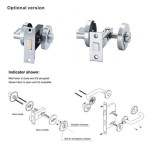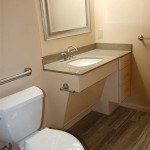How To Dehumidify A Bathroom Naturally
Bathrooms, by their very nature, are prone to high humidity levels. Showers, baths, and even running the tap can introduce significant amounts of moisture into the air. This elevated humidity can lead to a variety of problems, including mold and mildew growth, unpleasant odors, and even damage to paint, wallpaper, and fixtures. While electric dehumidifiers are effective, they consume energy and can be noisy. Fortunately, several natural methods exist to effectively dehumidify a bathroom, promoting a healthier and more comfortable environment.
Understanding the factors contributing to bathroom humidity is the first step in implementing effective natural dehumidification strategies. Warm water evaporating into the air is the primary source. Poor ventilation exacerbates the issue, trapping moisture and preventing it from escaping. Inadequate insulation can also contribute, as cold surfaces encourage condensation. Addressing these underlying issues, alongside specific dehumidification techniques, will yield the best results.
Improve Ventilation
Proper ventilation is paramount in controlling bathroom humidity. The goal is to efficiently remove moist air and replace it with drier air from elsewhere in the house or from the outside. Several strategies can improve bathroom ventilation naturally.
The most immediate and often overlooked step is to simply open a window while showering or bathing. Even a small crack can significantly reduce humidity buildup. If the bathroom has no window, ensuring the bathroom door remains open after use can facilitate airflow and allow moisture to dissipate. This allows the humidity to spread out into the rest of the house, which is typically drier than the bathroom environment.
Using a bathroom fan is another essential component of effective ventilation. However, the fan's effectiveness depends on its size and usage. A fan's capacity is measured in cubic feet per minute (CFM). A general rule of thumb is to have at least 1 CFM per square foot of bathroom space. For example, a 50-square-foot bathroom should have a fan with a CFM rating of at least 50. Furthermore, the fan must be used consistently. It should be switched on before starting a shower or bath and left running for at least 20 minutes afterward to ensure that all the moisture-laden air is adequately removed.
The placement of the bathroom fan is also crucial. Ideally, it should be located near the shower or tub, as this is where the most moisture is generated. The fan should also be properly vented to the outside. Venting the fan into the attic or another enclosed space will simply redistribute the moisture, potentially leading to problems in those areas. Regularly cleaning the fan is necessary to maintain optimal performance. Dust and debris can accumulate, reducing airflow and diminishing its effectiveness.
Employ Moisture-Absorbing Materials
Certain natural materials possess inherent moisture-absorbing properties that can help dehumidify a bathroom. These materials passively draw moisture from the air, reducing humidity levels without requiring electricity or active intervention.
Activated charcoal is a highly effective moisture absorber. Its porous structure allows it to trap moisture molecules, effectively removing them from the air. Small bowls or containers filled with activated charcoal can be strategically placed around the bathroom, particularly in areas prone to dampness, such as near the shower or sink. Regularly replacing or reactivating the charcoal is necessary to maintain its effectiveness. Reactivation can be achieved by placing the charcoal in direct sunlight for several hours, allowing the trapped moisture to evaporate.
Rock salt, particularly coarse sea salt, is another readily available and inexpensive moisture absorber. Similar to activated charcoal, rock salt draws moisture from the air through a process called hygroscopy. Placing bowls of rock salt in the bathroom can significantly reduce humidity levels. As the salt absorbs moisture, it will gradually dissolve. The resulting salty water should be discarded, and the salt replaced regularly.
Silica gel packets, often found in packaging for electronics and other moisture-sensitive items, can also be repurposed for dehumidifying a bathroom. These packets contain silica gel, a desiccant that effectively absorbs moisture. While individual packets may not have a significant impact, collecting and placing a large number of silica gel packets in a container can contribute to reducing humidity. Like activated charcoal, silica gel packets can be reactivated by heating them in an oven at a low temperature to remove the absorbed moisture.
Certain plants also contribute to humidity control. While not as potent as desiccants, they can help absorb excess moisture from the air through their leaves. Plants like Boston ferns, peace lilies, and English ivy are known for their moisture-absorbing properties and thrive in humid environments. Placing these plants in the bathroom can add a touch of greenery while also contributing to natural dehumidification. However, it's important to note that plants alone will not solve a severe humidity problem and should be used in conjunction with other strategies.
Control Moisture Sources
Minimizing the amount of moisture released into the bathroom air is a proactive approach to natural dehumidification. Modifying showering habits and addressing plumbing leaks can significantly reduce humidity buildup.
Shorter showers and cooler water temperatures can minimize the amount of steam generated, thereby reducing humidity. While a long, hot shower may be relaxing, it releases a significant amount of moisture into the air. Opting for shorter showers and slightly cooler water temperatures can noticeably reduce humidity levels. Furthermore, ensuring the shower door or curtain is properly closed during use prevents moisture from escaping throughout the bathroom.
Addressing any plumbing leaks, no matter how small, is crucial. Even a slow, dripping faucet or leaky pipe can contribute to increased humidity over time. Regularly inspect faucets, pipes, and showerheads for leaks and repair them promptly. This not only reduces humidity but also conserves water and prevents potential water damage.
Wiping down wet surfaces after use can also help minimize moisture buildup. After showering or bathing, use a squeegee or towel to wipe down the shower walls, door, and surrounding surfaces. This removes standing water and prevents it from evaporating into the air. Similarly, wiping up water spills around the sink and toilet can help keep humidity levels in check.
Properly storing towels and bathmats is another important consideration. Damp towels and bathmats can contribute to humidity as they slowly release moisture into the air. Ensure towels are hung up to dry properly after each use. Ideally, they should be hung in a well-ventilated area outside the bathroom. Bathmats should also be hung up or laundered regularly to prevent moisture buildup.
The use of exhaust fans and adequate ventilation in the bathroom in conjunction with some or all of these methods will greatly reduce the humidity within the bathroom, inhibiting mold growth and creating a more comfortable, healthy environment for the user. Regular evaluation of the methods used will allow for fine-tuning the process and may require adding or removing elements of the overall plan.

How To Make A Homemade Dehumidifier Diy Dehumidifiers

15 House Plants That Help Reduce Humidity In The Bathroom

How To Reduce Humidity In Your Bathroom Bath Fitter

15 House Plants That Help Reduce Humidity In The Bathroom

Indoor Humidity Beat It With A Diy Dehumidifier And Other Natural Ways

Homemade Mold Prevention Spray Tips To Clean In Shower

How To Reduce Humidity In Your Bathroom Bath Fitter

Fresh And Healthy Bathing Spaces Ten Bathroom Plants That Absorb Moisture Article On Thursd

11 Natural Dehumidifier Plants To Keep Indoor Humidity Under Control

How To Reduce Humidity In Your Bathroom Bath Fitter







